ALMA, aided by a gravitational lens, imaged the outflow, or “wind,” from a galaxy seen when the universe was only one billion years old. The ALMA image (circle call out) shows the location of hydroxyl (OH) molecules. These molecules trace the location of star-forming gas as it is fleeing the galaxy, driven by either supernovas or a black-hole powered “wind.” The background star field (Blanco Telescope Dark Energy Survey) shows the location of the galaxy. The circular, double-lobe shape of the distant galaxy is due to the distortion caused by the cosmic magnifying effect of an intervening galaxy.
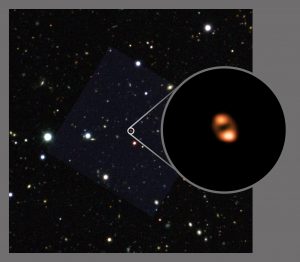
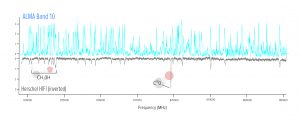
Spectral Lines in the Cat’s Paw Nebula
The upper blue portion of this graph shows the spectral lines ALMA detected in a star-forming region of the Cat’s Paw Nebula. The lower black portion shows the lines detected by the European Space Agency’s Herschel Space Observatory. The ALMA observations detected more than ten times as many spectral lines. Note that the Herschel data have been inverted for comparison. Two molecular lines are labeled for reference.
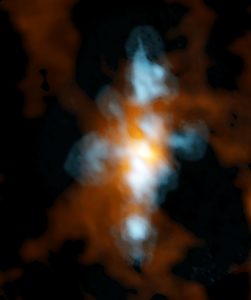
Heavy Water in NGC 6334I
Composite ALMA image of NGC 6334I, a star-forming region in the Cat’s Paw Nebula, taken with the Band 10 receivers, ALMA’s highest-frequency vision. The blue component is heavy water (HDO) streaming away from either a single protostar or a small cluster of protostars. The orange region is the “continuum emission” in the same region, which scientists found is extraordinarily rich in molecular fingerprints, including glycoaldehyde, the simplest sugar-related molecule.
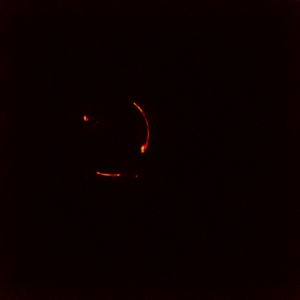
VLBI Network of Telescopes Bring Astronomers Closer to Understanding Dark Matter
Gravitational lensing allows astronomers to observe incredibly distant radio sources that cannot be directly detected. By observing how the radio emission from the distant source is bent by the gravitational field of a massive object – the lens – located between the source and the Earth, it is possible to determine information about both the distant source and the lens. In this study, the researchers used the radio source MG J0751+2716, at such great a distance that it has taken the light 11.7 billion years to reach the Earth. This object is comprised of a black hole with a powerful ejection of material, known as a jet. The lens consists of a group of galaxies located 3.9 billion light-years from Earth.
The image was created by combining data from a global network of radio telescopes, including the continental Very Long Baseline Array (VLBA), European VLBI Network and Green Bank Telescope in West Virginia United, in an effort to address some of the fundamental questions about dark matter. The international team of astronomers aim to determine how much dark matter is present in galaxies and how it is distributed. According to current theories, a galaxy, such as our Milky Way, should have thousands of dwarf galaxies orbiting around it, yet to date only approximately 100 have been found.
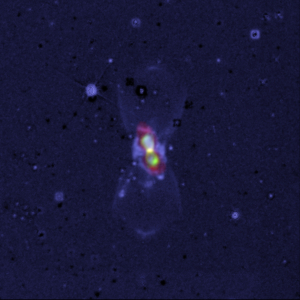
Pair of Colliding Stars Spill Radioactive Molecules into Space
A widefield, composite image of CK Vul, the remains of a double-star collision. This impact launched radioactive molecules into space, as seen in the orange double-lobe structure at the center. This is an ALMA image of 27-aluminum monofluoride, but the rare, radioactive isotopic version of AlF resides in the same region. The red, diffuse image is an ALMA image of the more extended dust in the region. The blue is optical hydrogen emission as seen by the Gemini observatory.

First Detection of Aluminium Nuclear Isotope in Space
Composite image of CK Vul, the remains of a double-star collision. This impact launched radioactive molecules into space, as seen in the orange double-lobe structure at the center. This is an ALMA image of 27-aluminum monofluoride, but the rare isotopic version of AlF resides in the same region. The red, diffuse image is an ALMA image of the more extended dust in the region. The blue is optical hydrogen emission as seen by the Gemini observatory.





